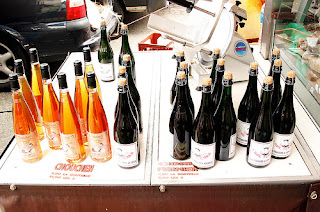Sauce Béchamel
Sauce Béchamel
Sauce
Béchamel is a white sauce that at its simplest is made with butter, flour, and milk flavored with nutmeg. It has been part of
French cuisine since at least the mid-1600s when it was named after Louis
de Béchamel Marquis of Nointel, (1630-1703). Louis de Béchamel was King Louis
XIV of France’s Finance Minister and his tax collector. As such Béchamel flattered
by having many dishes named after him; however Sauce Béchamel is the only
recipe with his name that has survived. (BTW King Louis XIV built the Chateau de
Versailles).
Sauce Béchamel is a mother sauce.
A mother sauce may be served on its own but its importance lies in
its use as a base for many other sauces. Nearly all creamy white sauces are the children of
Sauce Béchamel. Following on them a sauce
that develops from a child is, obviously the original sauce’s grandchild, The
most well-known children of Sauce Béchamel are listed towards the end of this
post.
Salmon and Sauce Bechamel.
Sauce Béchamel on French menus:
Gratin d'Aubergine, Pommes de Terre et Viande Hachée à la Sauce Béchamel - Aubergines, USA eggplants, mashed potatoes
and chopped beef covered with a Béchamel sauce; cooked and browned in
the oven.
Pâtes Farcies au Veau et
Épinard, Nappées d'une Sauce Tomate et Béchamel, le Tout Gratiné -Fresh
pasta stuffed with veal and spinach and served with an oven-browned
tomato and Béchamel sauce.
Lasagna alla Besciamella
That’s
Italian for lasagna with Béchamel sauce.
The French use many
Italian recipes and the Italians have returned the compliment with Sauce
Béchamel mostly called La Besciamella.
Good recipes are for
sharing.
Choux-Fleur à la Béchamel Gratinée - Cauliflower covered
with Béchamel sauce and browned
under the grill.
Gratiné
de Noix de Saint-Jacques en Béchamel - The meat of the king scallop cooked
with béchamel sauce and browned
under the grill.
Stuffed red peppers with Sauce Bechamel.
www.flickr.com/photos/jlastras/4531446575/
Pain
de Mie, Jambon Blanc, Béchamel, Tomates et Gruyère
- A sandwich of sliced bread with
cooked ham, tomatoes,
and Gruyere
cheese; covered with Sauce Béchamel. In France, at lunchtime, sandwiches, and croissants
stuffed with ham, cheese or vegetables will be on many menus with many
coming with Sauce Béchamel.
The children of Sauce Béchamel
The most well-known children of Sauce Béchamel are Sauce
Aurore. Sauce Mornay, Sauce Nantua, and Sauce Soubise.
Sauce Aurore
Sauce Aurore is Sauce Béchamel with added tomato puree
and crème
fraiche with a hint of garlic. The sauce’s color gave the sauce its name;
aurore means dawn in French.
Cauliflower
with Sauce Aurore Gratiné
Sauce Mornay
Sauce Mornay is Béchamel’s most famous child and it is
simply made by adding Gruyere
or Parmesan
cheese to the Béchamel Sauce. The sauce’s original recipe and
the claim that it was named after Philippe de Mornay (5 November 1549 – 11
November 1623) is disputed as Philippe de Mornay died before Louis de Béchamel
was born. However, there are other Duke's de Mornay in French history.
Sauce Nantua
Sauce Nantua is a Béchamel sauce originally made with freshwater
crayfish and their shells from around the town of Nantua in the department of Ain
in the Auvergne-Rhône-Alpes. Today, from
over-fishing and pollution any crayfish on Nantua menus will not be local and
more often than not a lobster
bisque
or shellfish shells replace the crayfish with tomato paste assisting with the
sauce’s color.
Pike (the fish) dumplings
with Sauce Nantua.
Sauce Soubise
Sauce Soubise is a Sauce Béchamel flavored with veal stock, butter, fried onions, crème
fraiche, and nutmeg. In Paris, there is a Hôtel de Soubise that
was built for the Prince and Princess de Soubise in 1375. The sauce was named after Prince Soubise,
Charles de Rohan (1715 – 1787) and the Hôtel de Soubise is now the French National
Archive Museum.
( N.B. Sauce Béchamel and the four other
Mother sauces of French have many children and grandchildren. The five sauces
are Béchamel; Espagnol, a brown sauce; Hollandaise;
Veloute;
and Tomate, a thick tomato-based sauce.
---------------------------
Behind the French Menu
by
Bryan G. Newman
behindthefrenchmenu@gmail.com
Copyright
2011, 2012, 2014, 2015,2019
---------------------------
Searching for the meaning
of words, names or phrases
on
French menus?
Just add the word, words, or phrase that you are searching for to
the words "Behind the French Menu" (best when including the inverted
commas), and search with Google or Bing, Behind the French Menu’s
links include hundreds of words, names, and phrases that are seen on French
menus. There are over 450 articles that include over 4,000 French dishes with
English translations and explanations.
--------------------------
Connected Posts:
Tomate –
Tomato. France’s Greatest Tomato, the Tomate de Marmande AOC. The Tomato in
French Cuisine.













